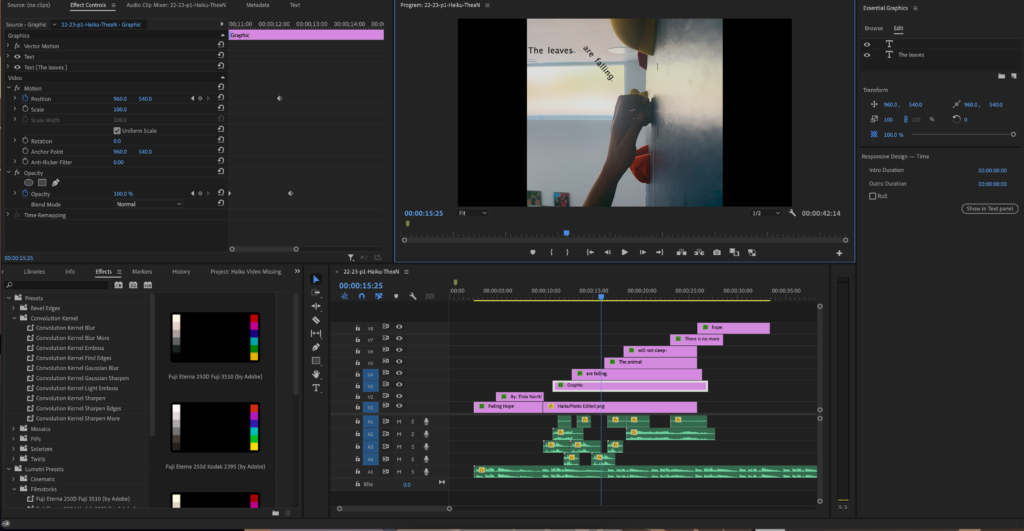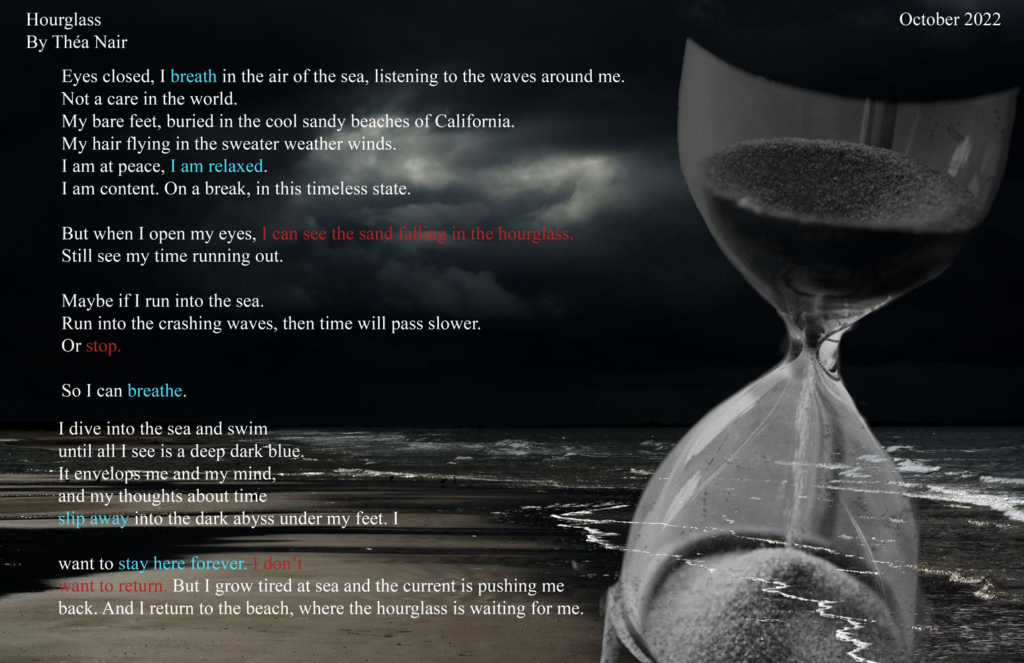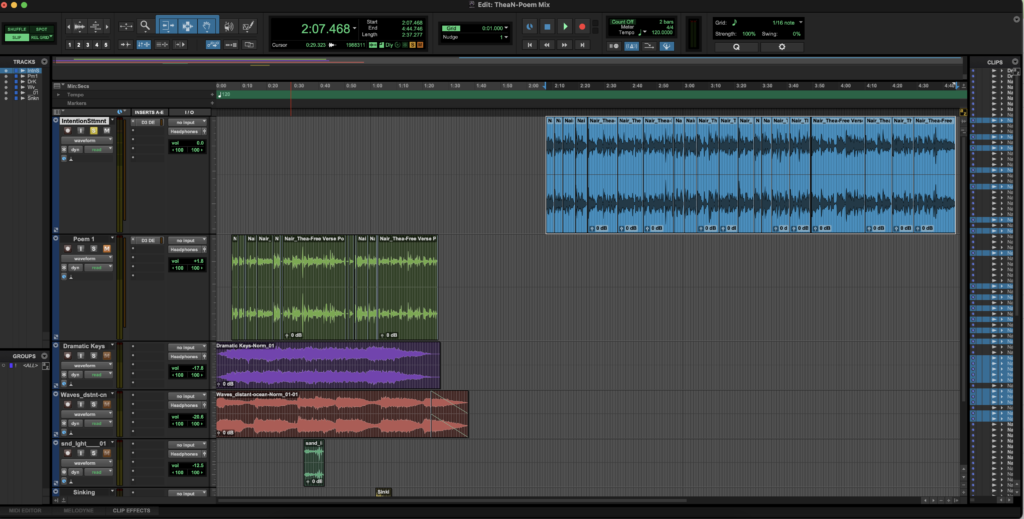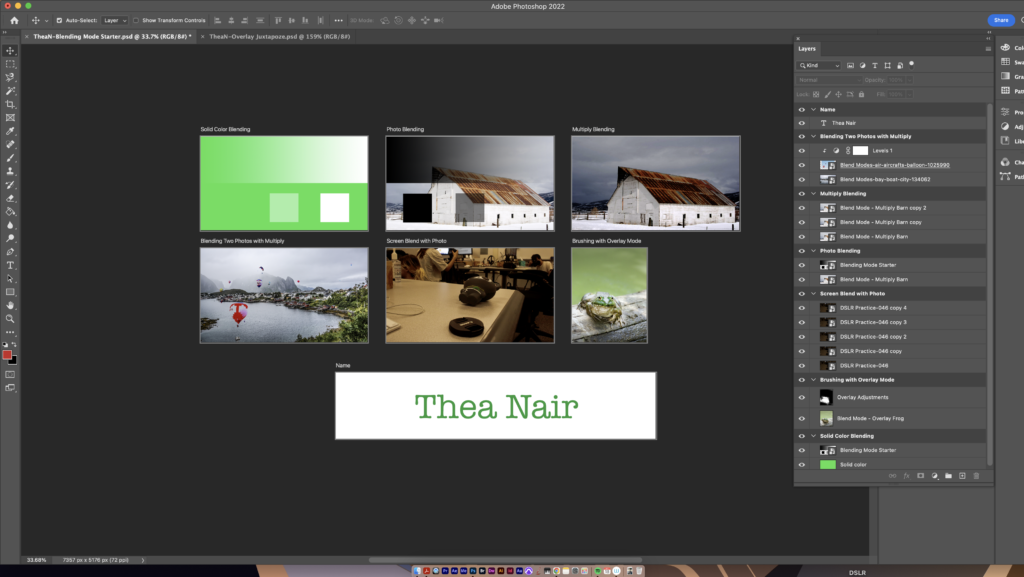Introduction
Throughout the Conceptual Unit we were tasked with communicating and expressing our opinions through poetry, art, experimental film and web production. We expanded our technical expertise by learning how to use DSLR Cameras, Tascam Audio Recorders, Adobe Photoshop, Adobe Animate, Premiere Pro, Adobe After Effects, Avid Pro Tools, and WordPress.
In my first semester in Digital Media/English I have learned many new skills that I can now use for my own projects. I value the amazing supportive community that I found in freestyle. I value the freedom I have here at freestyle, the classes make me feel like I am in control of my learning. And I will continue to put everything I have into it so I can get as much out of it as possible.
Photo Haiku
In English class our first unit focused on Poetry. We first learned about Haikus, a poem with 3 lines 5 syllables on the first, 7 on the second, and 5 on the last. We also had to take a picture that went with the Haiku. We were each given a concept statement that our poem would have to be based on we then had to take a photo that went with the theme of the poem. In digital media we took the image and the Haiku we wrote and animated them together on PremierPro.
My concept statement was “I am exploring the feeling of agitation through taking care of a pet”. After this unit I have a new found appreciation for imagery both figurative and visual.

Poetry
The second unit was also focused on Poetry. In English we read many free verse poems and then we wrote one of our own. In Digital Media we used Pro Tools and Photoshop to further immerse the viewer in the poem.

My intention Statement: “Hourglass” is a free verse poem about the passing of time. The speaker in this poem is someone troubled with how quickly time passes; throughout the poem, the hourglass poses as an unwelcome reminder to the speaker. In the first stanza the speaker is content and relaxed. In the first and third stanza I have described the surroundings and setting so the reader is able to situate themselves. In the third verse I use sensory imagery to help immerse the reader into the relaxed tone of the first stanza; their feet are buried in the cool sand and with wind flying through their hair. I used end-stop lineation at the end of most of my verses because each line is its own complete thought. Throughout the poem I use assonance and consonance. For example, the first stanza and fourth verse, reads: “sweater weather winds”. The tone of the first stanza is meant to convey a feeling of togetherness and solidity. The speaker is sure of themselves in the moment. They are at peace. Moving on to the second and third stanzas, the tone of the poem shifts. The speaker becomes hesitant of themselves and they begin to feel more pressured by the figurative hourglass that looms over them. The hourglass represents the passing of time and as a student I can attest that there is never enough time to relax. There is always a next project or chapter to begin. In the second stanza the poem once again uses consonance, “sand”, “still”, and “see”. The [s] sound pulls away from a tone of serenity to one of suffocation which continues in the third and fourth stanzas. In the third stanza we see the first line break that does not use punctuation. This is because I want the reader to focus on the word “stop”. I want it to have its own moment in the reader’s mind, to let it breathe, as it does for the speaker. In the fourth stanza the speaker tries to escape the concept of time. I use the metaphor of the ocean enveloping the speaker’s mind alluding to the idea of closing your mind and trying to become ignorant of the world. In the final stanza, the speaker inevitably returns to the beach. They are being pushed by the current and pulled by the hourglass because no one can escape time.
In order to make the reader experience the exact same feelings as my speaker, I punctuated each line to create a rollercoaster of emotion. They feel calm, only to then be alarmed and suffocated. They want to escape and finally surrender to their fears. In short, I want my readers to truly experience the constant struggle of trying to not let time and regimented schedules dictate their lives.
In this unit I learned a lot about the different nemonic devices used in poetry and how to use them effectively in a poem. I can also now use ProTools and Photoshop to add to my own independent work in the future.

Photoshop Blend Mode Editing
At the beginning of the basics of photoshop. And then we were introduced to adding blend modes to improve the images we wish to edit. Throughout the unit we experimented with the different Blend Modes.
The photoshop blend modes are useful to darken, lighten, or combine images.
With these new skills I can add my own creative touch to photos I take in the future.











Film
During the conceptual unit we learned about Experimental films. They are an abstract form of film. We started watching on of the most known Experimental Films “Meshes of the Afternoon” by Maya Deren. We then used our intention statements from the Photo Haiku Unit. We first pitched our original ideas to the class then after a brainstorming session we had a much better idea of what our Experimental was going to look like. After we shot our footage we spent the next couple of weeks in Premier Pro editing our Experimental and adding sound effects.

In my first months in film class I have learned more that I ever thought imaginable. After the Experimental unit we learned new filming techniques and the rules of film.
Here are some of the exercises we have done so far: